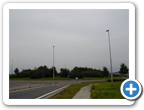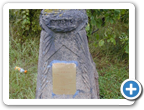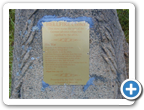The Western Front Today - Hellfire Corner
Until relatively recently the layout of the site of Hellfire Corner was little changed since the time when it was considered 'the most dangerous corner on earth'. Intersecting with the Menin Road it was an important route junction under constant observation and fire by Germans on the high ground.
Anything that moved across it was fired upon. Consequently canvas screens were erected beside the road in an attempt to conceal movement, much of which took place under cover of darkness, when the junction thronged with activity.
Today Hellfire Corner is a busy roundabout much used by through traffic. By the roadside is a demarcation stone - one of 12 surviving today in the Ypres Salient - marking the point of the Germans' closest advance to Ypres.
The metre-high stones, made from pink Alsace granite, were conceived in 1919. The sites of the stones were determined by Marshal Petain and his staff.
All bear the inscription (in three languages): "Here the invader was brought to a standstill 1918". At each corner was a palm emerging from a hand grenade.
It is not known precisely how many were constructed - estimates range from 119 to 280; many were destroyed by German troops during World War II who objected to the inscription upon the stones.
An original signboard that had marked Hellfire Corner was handed over to the National Army Museum in 1996. Long considered lost it was located by the family of Lt William Storie, who had brought it home with him after the war and displayed in a shop window in Prince's Street in Edinburgh.
Film Footage of Hellfire Corner (1)
Film Footage of Hellfire Corner (2)
References:
Before Endeavours Fade, Rose E.B. Coombs, After the Battle 1994
Major & Mrs Holt's Battlefield Guide - Somme, Leo Cooper 2000
Prevalent dysentery among Allied soldiers in Gallipoli came to be referred to as "the Gallipoli gallop".
- Did you know?



